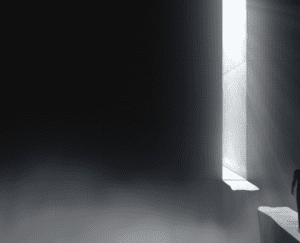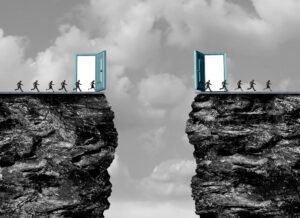The Scene(s). This reflection grew out of three recent scenes from my own life: my daughter’s college graduation, a visit with a dear friend who has breast cancer, and a run. The first two were one-of-a-kind events, momentous particularly for both my daughter and friend, with me there only as a loving witness. The third, an ordinary daily run spent listening to a podcast I’ve heard before without much impact on me, served as an unexpected bridge.
The Graduation. My daughter’s graduation was a joyous event. Our family gathered in Madison, WI to celebrate the successful end of her four years as an undergraduate. JJ Watt delivered a simple yet touching commencement speech recounting his time on campus and the years since, exhorting the new graduates to “Find a way to make a difference!” as he has done through his leadership both on and off the football field. He asserted that while the young adults in front of him may not yet fully know how they were going to do that – as he hadn’t while he was a proud Badger, either – hard work and giving to others should lead the way. My daughter and her friends were effervescent in their giddy sense of accomplishment, one foot firmly planted in adulthood and the other foot eagerly rising to join it. The Visit. Earlier that same week, I’d traveled to my childhood hometown of Cincinnati to see family and to spend time with a childhood friend who has stage three breast cancer. She’s one of the lucky ones, if there is such a thing with cancer. Her prognosis is hopeful, with the recovery and survival statistics soundly in her favor. Yet the chemotherapy treatments, the best means of ridding her body of the rogue cells, are wreaking short-term havoc on her health (which is already compromised by having lived with Type I Diabetes for 37 years). This visit marked the first time I’d seen her since her diagnosis. We held each other long and hard after she opened the front door of her house. She whispered into my ear, “I don’t want to have cancer anymore. I’m so tired.” We wept together. Two days later, we ventured out for blueberry pancakes…and her chemotherapy session. While there, she spent much of the time lying with eyes closed, concentrating on the work her body was doing to heal itself. She had asked me not to expect to talk with her during this process. So, instead, I gazed at her periodically, memories of our many moments together flitting through my mind. And I prayed for her.
The Juxtaposition. A college graduation and a visit with a sick friend. Wisconsin, Indiana, Illinois and Ohio. A busy week that involved hours driving from one section of the Midwest to another. A heart-filling sequence of events, most definitely. But it turned out to be more than that. Hang on for the connection. And for an offering of my internal musings for those of you who care to listen and reflect alongside me.
Running…to what? A few days after returning from both those events, on mile two of a run, I pulled up short to better listen to a passage in a podcast. Eckhart Tolle was describing a chapter from his best-selling book, A New Earth, and a particular lesson about conscious being. He raised many interrelated points which go well beyond the space I’ll use here. The most important points, filtered through how I heard them, were these: 1) Many of us approach life by focusing on ego-related pursuits and ways of defining our sense of self (see this link for another blog about defining self); 2) this orientation tends to result in a lot of doing so that we mostly experience ourselves as “human doings” versus “human beings;” and 3) the opportunity – he and other thought leaders in this space might even say the greatest calling – is to see through this DOING experience of the world and ourselves and instead drop into the more fundamental experience of our selves as BEING. What does that mean? It means being in the world, being present, in each moment, as purely and consciously as possible. Of course, yes, we have lives to lead and they require taking action in the world. But how much do we define ourselves by our actions? And judge others by theirs? And here’s the podcast excerpt that caused me to stop mid-way through that run. Eckhart was describing a thought from another book, Stillness Speaks. Here it is, recounted from my experience of it: envision the gravestones in any cemetery. Think of your future gravestone. Each has a birth year and a death year with a one- or two-inch dash in between those two dates. That dash represents all the activity, all the hopes, fears and anguish, that occurred in between those two dates. That’s it – a dash that takes up about one to two inches of space. And yet that’s what many of us pour our precious energies into, day in and out. Filling out that little dash with DOING. Here is the actual excerpt from the book: “What will be left of all the fearing and wanting associated with your problematic life situation that every day takes up most of your attention? A dash, one or two inches long, between the date of birth and date of death on your gravestone. To the egoic self, this is a depressing thought. To you, it is liberating.” The distinction Tolle is making in that last line is between what some call our egoic self, or false self, and our real self. Our egoic selves revel in puffing up the personal resume that stands behind that dash; our real selves know that authentic joy and our deepest sense of comfort come from releasing the need to prove anything.
Time as both vertical and horizontal. Try this: take a blank sheet of paper. Draw a horizontal line mostly across the width of that paper. Then draw a vertical line in the middle of that horizontal line, so that it bisects the horizontal line.  Perfect. This is a model that can be used to gain a quick but profound perspective on orientation to time, or the being and doing distinction. The horizontal line depicts the passage of chronological time – all the days and months and years that make up your life. The vertical line, in contrast, represents full awareness, full BEING, in any moment in time along that horizontal dimension of life. It’s the depth that is available, the tuning into the fullest experience of being present at any one point in time. It can therefore be a shorter line or a longer vertical line, depending on how tuned in we are to just being present in a moment.
Perfect. This is a model that can be used to gain a quick but profound perspective on orientation to time, or the being and doing distinction. The horizontal line depicts the passage of chronological time – all the days and months and years that make up your life. The vertical line, in contrast, represents full awareness, full BEING, in any moment in time along that horizontal dimension of life. It’s the depth that is available, the tuning into the fullest experience of being present at any one point in time. It can therefore be a shorter line or a longer vertical line, depending on how tuned in we are to just being present in a moment.
Finding Our Way. The connection struck me as I stood stock still. My friend has found this practice for her chemotherapy sessions, without even knowing that’s what it’s called. She has found a way to stop time and just BE with the experience she is going through, tuning into all that it holds. Her organic, bodily sense of how to best care for herself through the experience of chemotherapy has led her there naturally, amidst the noise of the infusion pump and thin curtained-alcoves containing other nearby cancer patients and their loved ones. And my daughter and her friends, suspended in time through the events of that graduation weekend, on the precipice of beginning their “grown up jobs” or heading off to gap year adventures seemed wholly immersed in the moment as well, even while being gently guided by their commencement speaker to think ahead along their own horizontal lines. There I stood, mid-run, also suspended in time, as I made the connection between these recent big life events. The juxtaposition was now feeling more meaningful than random. New awareness washed over me. Then I re-started my run. Ha! The push to finish that aspect of my horizontal journey taunted me. This time, though, I practiced holding onto each present moment of the remaining miles as they flew by: the feel of my footfalls on the pavement, the sensation of my breath as it moved in and out of my chest, the sunlight as it warmed my head. Is that what an awakened life is: holding both the horizontal and vertical, consciously? Hanging out in the intersection.
Practices to Strengthen the Vertical. How can we strengthen our ability to hang out in the vertical dimension, in BEING, more often? I’ve covered several methods in other blogs, so I’ll provide a brief overview of three methods here (listed from least time consuming to most):
- Seek Novelty: Ellen Langer, who some call “the mother of mindfulness,” promotes an eminently practical approach to mindfulness. To combat our tendencies to engage in automatic, mindless, patterned behaviors for much of our day, she urges us to simply find novel ways to engage in everyday situations. So, as you are engaged in a routine activity, or any time you need to increase your ability to pay attention to the present moment, adopt a practice of looking around the situation and noticing 5 new things (e.g. the color of someone’s sweater, the way the carpeting meets the walls in the corner of the room, etc.). Or vary your routine – walk a different path to the meeting room in which you have your leadership drumbeat meeting every Monday. Pay attention as you do so. It doesn’t work to introduce novelty to your routine if you aren’t dialed in as you do it.
- Tune into Your Heart Center: the HeartMath Institute provides a portfolio of powerful methods for accessing deeper states of awareness that do not require more than a couple of minutes of practice each time you use them. If you are new to their methods, try the Quick Coherence® and Inner Ease®
For your convenience, here is an overview of the quick coherence technique:
Step 1: Focus your attention in the area of the heart. Imagine your breath is flowing in and out of your heart or chest area, breathing a little slower and deeper than usual. You could try to inhale for 5 seconds, then exhale for 5 seconds (or whatever rhythm is comfortable for you).
Step 2: Make a sincere attempt to experience a regenerative feeling such as appreciation, gratitude or care for someone or something in your life. Continue your heart-focused breathing as you do so.
- Build a Meditation Practice: I know many folks who have struggled to build a regular meditation practice…and more who have benefitted greatly from sticking with the attempt to do so. Even 5 – 10 minutes a day of centered breathing and non-judgmental observation of your thoughts and feelings can make a difference. There are a number of wonderful apps you can download on your phone at this point. A personal favorite is Headspace (I’ll confess to having a slight crush on the voice of the founder, Andy Puddicombe, who narrates all the Headspace meditations).
Turning a Minus into a Plus. Taking a step back and re-reading what I’ve written here, it strikes me that someone could get lost in confusion about my usage of the two geometrical metaphors: the dash and the vertical/horizontal axes. I’ll try to reconcile them, provide an application, and then pose a final reflection. Here it is: do we want to live as horizontal line people (or “dash people,” since a dash is an abbreviated horizontal line, after all) – chasing achievements, more stuff, and better stories to tell about ourselves that satisfy our egos? Or do we want to live more as vertical line people – more fully present with our real selves, with others, and with our experience? I’m suspicious of binary choices, so I’m thinking the way to go is a “both/and”. Doubtless, we each naturally spend time in the vertical dimension during one-of-a-kind life events where time feels suspended, as it was for my daughter and for my friend in those recent scenes. And, frankly, it’s rather illogical to suggest we stop living in chronological time. The opportunity before us, then, is to live and lead (ourselves and others) with more awareness of the vertical, of BEING, as well as to cultivate practices to spend even more time hanging out in that intersection.  Approaching life as a plus sign – horizontal and vertical in balance – now there’s a thought. And perhaps if we do enough intentional living of life as a plus sign (which for most of us would mean spending more time cultivating the vertical aspect of our life lines), we can actually make our horizontal line thicker. In other words, our actions would become more conscious, purposeful, aligned with our real selves, and therefore, more meaningfully impactful in the world.
Approaching life as a plus sign – horizontal and vertical in balance – now there’s a thought. And perhaps if we do enough intentional living of life as a plus sign (which for most of us would mean spending more time cultivating the vertical aspect of our life lines), we can actually make our horizontal line thicker. In other words, our actions would become more conscious, purposeful, aligned with our real selves, and therefore, more meaningfully impactful in the world.
Application. I recently worked with a coaching client with whom this balanced, “doing AND being” approach led to a deeply insightful conversation. Reflecting on several career path choices she has in front of her, she expressed a sense of being overwhelmed and uncertain about how to go about making the decision. “I feel frozen in place – I’m not sure whether to stay in this job several more years, accept an offer to join the start-up company that’s been courting me, or leave the corporate world entirely to finally begin the think tank work I’ve long envisioned for myself.” It seemed clear that she’d spent time analyzing the decision thoroughly from an intellectual standpoint, without achieving enough clarity to move forward. Sensing it might be helpful to drop her into a different mode of exploration, I guided her through a drawing of the horizontal & vertical line illustration, explaining the distinction between the two orientations to time. Then we engaged in some heart-focused breathing together. As we sat in the stillness afterward, I invited her to talk about the elements of each option again. This time, however, we tuned into her organic sense of being energized or drained as she did so. We found ourselves mapping the variations of energy in her voice, stomach and chest – the highs and lows – associated with various factors that distinguished the options, such as “provides flexibility for the mom part of my life,” “helps me build a network that could also support the philanthropic organization I dream of starting someday,” and “represents work that feeds my deeper sense of purpose.” She left our session palpably lighter in spirit, with a commitment to repeat this type of inner attunement process to continue advancing her decision making. While her final decision is yet to be made, the exercise helped her to break through her sense of being stuck and increased her confidence that a deeper wisdom is available to guide her if she taps into it. For me, the experience was a wonderful reinforcement of the value of dropping into the inner guidance available in deep presencing or the BEING dimension – and then using what we learn to inform our actions or DOING. Living the plus sign.
Final Musing. Because I am a visual thinker, Eckhart Tolle’s powerful words about that dash frequently call a personal scene to my mind these days, both while running and not. When my gravestone is etched someday, I’ve decided I’ll take my stand (metaphorically speaking) as a plus sign person. I now plan to ditch the dash and instead, have my gravestone inscribed as follows:  How about you?
How about you?





